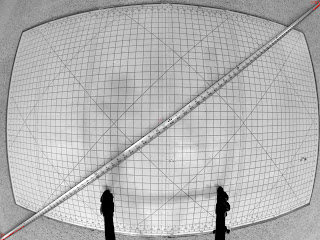Total Lunar Eclipse - 15 May, 2022
Last night was a total lunar eclipse. Notably, the partial phase started shortly after moonrise here in Fort Collins, so the moon was fairly low in the sky for most of the eclipse. This means it was a good opportunity to get a composite photo of the lunar eclipse with the city lights of Fort Collins in the foreground. Some messing about with Google Maps yielded the top of the trail at Reservoir Ridge Natural Area as the best spot. I drew a map showing the field-of-view of my chosen equipment:
The red lines show the azimuth of the moon at the beginning and ending of the eclipse, and the green triangle shows the field-of-view of the camera when placed in portrait orientation. I submitted a request for permission to stay on the natural area property after hours. With permission in hand, I packed up my bag. 2 cameras and lenses, a computer, spare batteries, and two tripods. 27 pounds worth:

I also schlepped up to the top of the trail with a folding chair and small folding table. Other equipment included a coat, a hat, a can of bear spray, and bear bells. I did *not* want to encounter large carnivores after dark...
I reached the trail summit at about 7:10 PM and set up my equipment. On the left is a Canon EOS R5 with a 24-70mm f/2.8L lens (set to 24mm f/2.8). On the right is a Sony RX10IV, picked because of its decent zoom lens at a very light weight. In the foreground is the computer I used to control the Canon. It's a lot easier to see if you are in critical focus on a computer monitor. You can see the moon rising through the murk just to the left of the tripods:

While waiting for the main event, I took a panorama of my photo location:
As the event proceeded, I also took some glamor shots of the eclipse, the city lights, and the camera equipment:
I took photos every 5 minutes, using a stopwatch app on my phone (so, not *exactly* every 5 minutes...). I took multiple exposures at each stop, typically 4. Exposures on the EOS R5 ranged from 1/8000s at ISO 400 to 0.5s at ISO 3200. Exposures on the Sony RX10IV ranged from 1/4000s at ISO 400 to 1/4s at ISO 1600. Although the Sony lens is slower at f/4, I mostly tended toward shorter exposures during totality due to the much longer focal length (10x longer focal length and finer pixel pitch). The range of exposures is necessary because of how much the brightness of a lunar eclipse varies. And no two eclipses are the same. This one was fairly dark for two reasons. First, the beginning was dimmed by all the atmosphere the light was coming through. Second, the total phase passed almost directly through the center of the Earth's shadow, which made it much darker.
When the eclipse ended, I had 214 photos on the Canon and 181 photos on the Sony in-hand. The full moon was nice and bright, so I took a photo of my shadow with my cell phone:
Finally, I did a collage showing the actual position of the Moon relative to the Earth's shadow. I added a border of the 5-minute interval images. This is also entirely RX10IV images:
Higher-res versions of the labeled collages may be found here:
And so concludes another successful eclipse expedition. Counting down the days until November 8, 2022...
Edit: there is now a video:









Comments